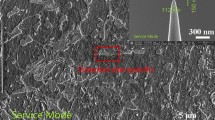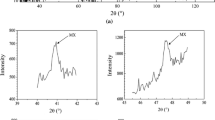Abstract
Phosphorus is a very common trace element that can segregate at prior austenite grain boundaries and/or carbide/matrix interfaces of low alloy steels at high temperature (e.g., order of 500 °C) and adversely affect the fracture properties. This paper investigates segregation of P during reversible temper embrittlement (96 h at 520 °C) of quenched and fully tempered 2.25Cr-1Mo steel by Auger electron spectroscopy and describes the segregation mechanism. This paper also describes the effect of P segregation on fracture resistance and fracture mode of unembrittled steels, respectively, by fracture toughness testing over a temperature range of −196 °C to 20 °C and fractography in scanning electron microscopes. During temper embrittlement phosphorus segregation has been attributed due to the mechanism of “carbide rejection”. This segregation caused a reduction in fracture toughness values of the quenched and tempered steels at all test temperatures and an increase in the transition temperature. Phosphorus segregation also changed the brittle fracture micromechanism of quenched and fully tempered samples from one of transgranular cleavage to a mixed mode of fracture (transgranular cleavage and intergranular decohesion). The micromechanism of fracture at temperatures from the upper shelf, however, remained almost unchanged.
Similar content being viewed by others
References
R.C. Thomsons and S. Miller: “Carbide Precipitation in Martensite During the Early Stages of Tempering in Cr- and Mo-Containing Low Alloy Steels,” Acta Mater., 1998, 46(6), pp. 2203–13.
J.I. Akther, M. Ahmed, and S. Shaikh: “Effects of Heat Treatments on Hardness and Precipitation in 2.25Cr-IMo NiNb Stabilized Ferritic Steels,” Mater. Sci. Lett., 1996, 15, pp. 905–08.
R. Pilkington, R. Dicken, P. Peura, G.M. Lorimer, G.C. Allen, M. Holt, and C.M. Younes: “Trace Element Embrittlement in 2.25%Cr1%Mo Steel,” Mater. Sci. Eng., 1996, A212, pp. 191–205.
J.J. Lewandowski, C.A. Hippsley, M.B.D. Ellis, and J.F. Knott: “Effects of Impurity Segregation on Sustained Load Cracking of 2.25Cr-1Mo Steels-1. Crack Initiation,” Acta Metall., 1987, 30(3), pp. 593–608.
Anon: BS 7448, Fracture Mechanics Toughness Tests, Part 1, Method for Determination of KIC, Critical CTOD and Critical J Values of Metallic Materials, British Standard Institution, 1991, pp. 1–49.
M.A. Islam: “Intergranular Fracture in Embrittled 2.25Cr-1Mo Pressure Vessel Steel,” Ph.D. Thesis, 2001, University of Birmingham, Birmingham, UK.
C.J. McMahon, Jr., A.K. Cianells, and H.C. Feng: “The Influence of Mo on P-Induced Temper Embrittlement in Ni-Cr Steel,” Met. Trans., 1977, 8A, pp. 1055–57.
M.B.D. Ellis: “Observation of Temper Embrittlement in 2.25Cr-1Mo Steel,” Ph.D. Thesis, University of Cambridge, Cambridge, UK.
V. Jayan, P.K. Mandal, M. Hirani, and S.K. Sanyal: “X-Ray Investigation of Carbide Precipitation in 2.25Cr-1Mo Steel for Predicting Remaining Life of Boiler Components After Extended Service in Fossil Fuel Fired Power Stations,” Mater. Sci. Technol., 1999, 15, p. 1308.
J.G. Zhang, F.W. Noble, and B.L. Eyre: “Comparison of Effects of Aging on Fracture of 9Cr-1Mo and 2.25Cr-1Mo Steel,” Mater. Sci. Techn., 1991, 7, p. 218.
M. Wada, K. Hosoi, and O. Nishiwaka: “FIM Observation of 2.25Cr-1Mo Steel,” Acta Metall., 1982, 30, pp. 1005–11.
M. Wada, S. Fucase, and O. Nishiwaka: “Role of Carbides in the Grain Boundary Segregation of Phosphorus in a 2.25Cr-1Mo Steel,” Scripta Mater., 1982, 16, pp. 1373–78.
J.E. King: Ph.D. Thesis, 1979, University of Cambridge, Cambridge, UK.
J.E. King and J.F. Knott: “Effects of Temper Embrittling Heat Treatment on Ductile Failure in High Strength Low Alloy Steel,” Met. Sci., 1981, pp. 1–4.
Author information
Authors and Affiliations
Rights and permissions
About this article
Cite this article
Islam, M.A., Novovic, M., Bowen, P. et al. Effect of phosphorus segregation on fracture properties of 2.25Cr-1Mo pressure vessel steel. J. of Materi Eng and Perform 12, 244–248 (2003). https://doi.org/10.1361/105994903770343079
Received:
Revised:
Published:
Issue Date:
DOI: https://doi.org/10.1361/105994903770343079




